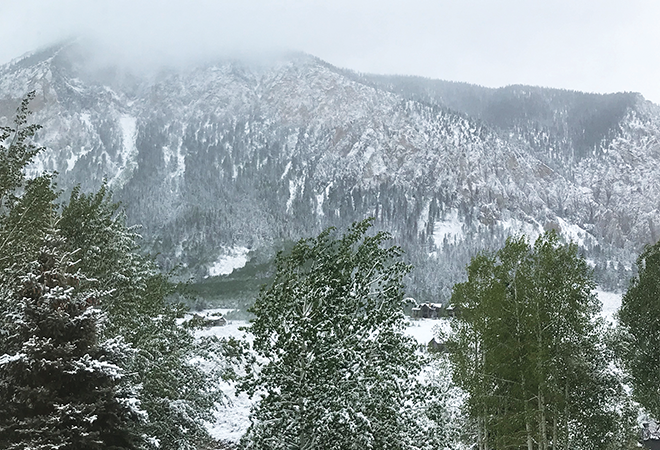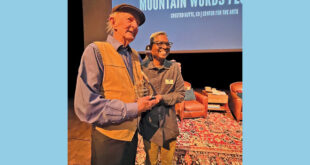By Allen Best
A storm that dropped up to a foot of snow in Colorado’s mountains on June 8 and June 9 this year was unexceptional. But how can snowstorms occur in June when temperatures in Colorado have been rising significantly in recent decades?
The short answer is that weather remains variable. The climate—the accumulation of weather over longer periods—has been warming, but not so much as to drown out the noise of short-term variability. On any given day, short-term variability will trump broader trends.
June snowstorms are part of that short-term variability.
Records taken at Aspen, Breckenridge and Climax—the mine between Leadville and Copper Mountain—all show frequent snow during June for the last 70 to 90 years.
June snow is not weird—yet. But in coming decades, it may be.
“I think there’s a strong likelihood we will be measuring some decline in late-season snowfalls in the next 30 years,” says Peter Goble, a climatologist with the Colorado Climate Center.
Temperatures have been rising across Colorado for the last 30 years, an average 2° F, but more so in some areas—western Colorado and particularly southwestern Colorado—than others.
It can still get cold—and record-breaking cold at that. But for every one new record low temperature in Colorado, there are three record high temperatures set, says Goble.
Along the Continental Divide north of Denver, the story is similar to that of ski towns on the Western Slope.
“Yes, June snows have become an endangered species at the 8,000- to 9,000-foot elevation level in the northern Front Range,” said Klaus Wolter, a former long-time staff member of the Earth System Research Laboratory at the National Oceanic and Atmospheric Administration. The same can be said about September snows, which were much more common as recently as the 1990s, he adds.
Wolter, who lives at around 9,000 feet near the old mining town of Ward, west of Boulder, said that it’s striking how big snow events have petered out in recent decades. But they still occur, as witnessed by the foot of snow that fell recently near Red Feather Lakes, northwest of Fort Collins.
And, to add a couple more wrinkles, the precipitation west of Boulder and Fort Collins might look very different west of the Continental Divide. He also points out that May temperatures have actually dropped 3° Fahrenheit at Ward in the last three decades. None of this is simple.
“As we have all just had a crash-course in how science works with COVID-19 (and I am sure we will learn plenty more about it than we ever wanted over the next few months), climate change has similar issues where what is considered firm ground at any given point may be a bit shaky after all.”
Firm is the effect on river runoff of warming springs such as this one.
The winter produced an “average+ snowpack,” as former general manager of the Colorado River Water Conservation District Eric Kuhn described it in a mid-April tweet. By then, the predicted inflow of the Colorado River into Lake Powell for April to June had declined to 75 percent of average.
Since then, the spring splish-splash into Powell, the second-biggest reservoir in the Colorado River Basin, has diminished even more, to just 57 percent of average, according to a report issued June 10 by the Western Water Assessment.
Looking back to mid-winter, there were higher expectations.
Who purloined the precipitation? It was likely a result of above-average temperatures.
Nearly all of Colorado and Utah had temperatures two to four degrees above normal, and some places in western and southern Colorado had temperatures up to six degrees above normal, the report said.
Colorado had average high temperatures in May that ranked among the top 10 highest for the month since 1895, as did Utah.
This is part of a well-defined warming trend in Crested Butte, Gunnison, Aspen and other locations in the Colorado River headwaters. The shift is documented on a website sponsored by the Aspen Center for Environmental Studies. It’s called the Forest Health Index. There you can study temperature, precipitation and other data for those river basins in Colorado that are at least one-third covered by trees. That’s most of them.
In the East and Taylor river area of Gunnison County (think Crested Butte to Almont), for example, the average temperature has bobbed up and down year by year since 1980, but there’s been a general rise. Think about the gentle slopes of Snodgrass, where the ski area expansion was planned a decade ago, and not the top 500 feet of Mt. Crested Butte.
Still, that’s a breathtaking change when compared with climatic shifts of the past. And this year looks to reinforce that trend. The National Oceanic and Atmospheric Administration in June predicted a very hot summer, maybe even a record year for heat. It said Colorado and other western states should expect above-average temperatures for July, August and September.
It’s part of a trend, notes the New York Times: “Each decade since the 1960s has been warmer than the one before, and the five hottest years occurred in the second half of the last decade.”
Globally, May was tied with 2016 for the hottest May on record, with average land and sea temperatures that were 0.95° C, or 1.71° F, above the average dating back more than a century. The five hottest Julys have occurred in the last five years, and nine of the 10 hottest have occurred since 2005.
But back in the Rocky Mountains, the trends in average peak streamflow are less clear. Precipitation also has giant ups and downs without a remarkable trend. Again, Crested Butte is not all that different from Aspen, Vail or Steamboat Springs.
The basins also have charts for frost-free days. This jumps around, too, but the trend is clearly toward a longer growing season, almost dramatically so—roughly double or a little more.
Adam McCurdy, director of forest and climate for the Aspen Center for Environmental Studies, says the numbers come from a combination of satellite, radar and station data to reflect the general state of the river basin. The Roaring Fork data, for example, does not reflect precisely the temperatures and precipitation in downtown Aspen. They’re a more general look at the Roaring Fork Valley.
Taking stock of the Colorado River Basin more broadly, scientists have been producing studies that detect a growing role of warming temperatures in the decreased river flows.
Jonathan Overpeck and Bradley Udall several years ago issued a study that found roughly half of the decreased flows in the Colorado in the 21st century were due to higher temperatures. The water was being taken up by increased evaporation but also transpiration by plants. In other words, what fell as snow and rain was returning to the atmosphere.
In a paper published in May in the Proceedings of the National Academy of Sciences, the two climate scientists—Overpeck from the University of Michigan and Udall from Colorado State University—dissect what is going on.
“It makes sense that longer growing seasons enabled by warming temperatures mean more total evapo-transpiration, drier soils and reduced river flows,” they say.
What about increased precipitation? After all, a warming atmosphere can hold more precipitation, about 7 percent per 1° C increase (1.8° F).
Outside the American Southwest, some areas have been getting more rain and snow. That unevenness holds true even within Colorado. The Durango area has been getting distinctly drier. Precipitation in the Denver-Greeley area, in contrast hasn’t changed all that much.
Overpeck and Udall would have us think of the Dust Bowl, a time during the 1930s on the Great Plains of both hot temperatures and drought. Recent “flash droughts” on the High Plains in 2012 and 2017 highlight how extreme spring and summer temperatures can speed the onset, and worsen the impact, of dry spells and droughts.
Now, it’s fire season, too. Gunnison County this year found itself in “exceptional drought” in May, while the Aspen area was still in moderate drought. In this particular case, Aspen was happy to let its smaller sibling resort south of the Elk Range to have the superlative.
Allen Best produces an e-magazine called Big Pivots, which focuses on climate change, energy and water in Colorado and beyond. To join the Big Pivots mailing list go to https://bigpivots.com/.
 The Crested Butte News Serving the Gunnison Valley since 1999
The Crested Butte News Serving the Gunnison Valley since 1999





